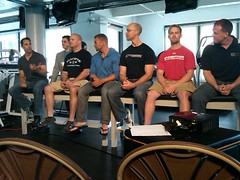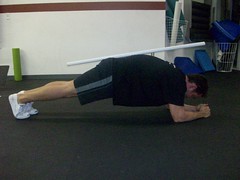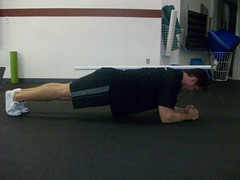Yesterday, in Part I, I started things off with some basic spinal anatomy (nerd alert) and then discussed how imperative it was to hone in on any postural deficiencies or imbalances that may be present in order to teach someone to get into a more neutral (ie: normal) spinal position when training.
Today, I want to delve a little more into the coaching side of things, and offer a few ideas/thoughts/suggestions that you may be able to either use yourself or with your clients and athletes.
Before we begin, however, I just have to get one teeny-tiny thing off my chest. No one has perfect posture – ever. Not even RoboCop.
Although, I have to say, after seeing this picture of myself from this past summer (where I was part of the “Expert Panel” at the Peak Performance Program Design Seminar), I come pretty darn close.
Not to brag or anything, but my posture is straight-up PWNING.

Anyhoo, with regards to perfect posture, one of my biggest pet peeves is when trainers spend an inordinate amount of time in “corrective” mode. And what I mean by this is that they’ll take a client through an assessment, whatever that may be, and then proceed to spend 45 minutes trying to correct the fact that their right big toe doesn’t dorsiflex three degrees.
Don’t get me wrong, I think it’s admirable that there are trainers out there who care THAT much to want to fix everything, and they they’re willing to actually assess people beforehand. But, lets not get too carried away here.
At the end of the day people also need a training effect, and in my experience, I can get much more done from an assessment standpoint getting people out on the floor moving around a bit. Seemingly, things tend to “shake free,” and I can better ascertain one’s overall movement quality when I have him or her out on the floor “doing stuff” than just having them lying down on a table for an hour bored out of their mind.
*steps off soap box*
Okay, with that out of the way , lets get started!
When I’m working with an athlete or even a general population client, I’m a pretty hands-on coach. I call it Play-Doh coaching, and all it basically means is that I’m not hesitant to place my hands on people and poke and prod (sometimes drop kick) to get them into the positions I want them to get into. This is especially true when trying to teach neutral spine to someone.
Take the prone plank, for example. Everyone knows what a prone plank is, and everyone does them at some point or another. Thing is, many trainees tend to epically fail when trying to perform it.

That’s intern Kyle you see up there in the picture. I asked him to drop down and get into a plank position that would make me cry. Fantastic job on his end, but truth be told, that’s what many people look like when they perform the exercise. Not pretty! In a perfect world the dowel rod would have three points of contact: the sacrum, the middle of the back, as well as the back of the head.
As you can see, that ain’t happening.
The dowel rod is a great tool because it provides fantastic kinesthetic feedback to the client so that they can “feel” where I want them to be.
Now as a coach, to start, I’d use my hands to “mold” him into the position I’d want. I’d tell him to widen his feet to give him more of a base of support. I’d tap his glutes to get them to fire, as well as his stomach to engage his core more. I’d gently push down on his upper back to get it into the proper position, and then I’d take my hands and place his head where I wanted it to be.
Ideally, it would end up looking something like this:

Much better. Again, the dowel rod is key here because it’s providing all the feedback Kyle needs to feel that he’s in the proper position and to maintain more of a neutral spine.
So, if you’re not quite picking up what I’m putting down, head down to your local Home Depot and purchase a dowel rod.
But what happens if we’re trying to teach something a bit more complicated – like the deadlift? It’s no surprise that I’m a huge fan of deadlifts, as I feel it’s a valuable exercise to learn no matter what one’s goals are.
As such, the dowel rod can be a useful tool in helping to groove proper hip hinge mechanics while simultaneously teaching trainees to pattern the deadlift with a neutral spine.
In much the same way, I’ll have the client place the dowel rod behind their back making sure to maintain three points of contact (sacrum, mid-back, and back of the head). From there, I’ll simply have him or her perform a hip hinge, like so:
Darth Maul re-enactments aside (you’ll have to watch the video to see what I mean. Unfortunately it was cut-off early), if at any point they lose contact with the rod, they know they’re not maintaining a neutral spine. To that end, this is a fantastic drill in of itself, and is something that can be used as part of a general warm-up or even as a filler exercise in between sets.
Taking it a step further, sometimes, and this doesn’t happen often, someone will smoke the dowel rod patterning drill, but when I have them attempt an actual deadlift, they turn right back into Quasimodo. When in the bottom position, they just can’t seem to differentiate between a neutral spine and what they’re back is actually doing.
In this instance I’ll use something as simple as the Cat-Camel drill.
Normally used as a t-spine mobility exercise, I’ve actually used it as a teaching tool to help people understand what it is I want them to do.
Literally I’ll have someone drop down into the quadruped position and have them purposely round their back (like a scared cat). I’ll have them note how that feels and say something along the lines of “feel that? Yeah? Well, stop it.”
Then, I’ll have them arch their back into a more neutral position (camel). Similarly, I’ll have them note how that feels, and tell them that I want them to repeat that same feeling when they set up t0 deadlift. For many, it works like a charm.
For those wondering: sexy tiger is optional.
Lastly, another simple drill that I’ve utilized in the past to help teach someone neutral spine, is to have them place their hands on their knees – kind of like what I basketball player does when he’s tired.
You’ll note that most will automatically maintain perfect spinal alignment. KA-CHING!!! From there, just have them inch down a bit further to grab the bar.
No one said we’re doing long division here, so there’s no need to make it more complicated than it has to be. It’s brutally simple drill, but it works.
And that’s about it. Of course, if you’re a trainer or coach, coaching your ass off is part of the equation. All of this is fine and dandy, but if you’re allowing sloppy form on everything, then it’s a complete waste of time (and you suck at life).
Collectively, between the drills I highlighted in part one, in addition to the drills discussed above, teaching someone how to attain a neutral spine should be within the realm of possibility.
I’d love to hear your thoughts on the matter. And ladies, for the record, Kyle is single. MEOW!



